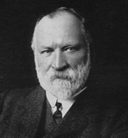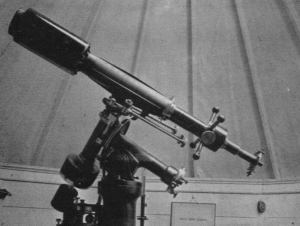| ROBERTS, Alexander William [Dr.]
Amateur Astronomer Born: 4 December 1857, Farr, Sutherland, Scotland |
|
|
|
|
| Famous for: Variable star observations, study of eclipsing binary systems. Summary: Roberts was very involved in politics. He was a very active amateur astronomer, specialising in Variable Star Observing. Between 1891 and 1920 Roberts discovered and monitored variable stars from a small observatory at the Lovedale Institution in the Eastern Cape. Never having an instrument with an objective larger than four inches, he was nonetheless able to contribute high-quality photometric data to the astronomical community of the time. Roberts’ attempts at determining the physical parameters of close binary systems, while not entirely successful, anticipated the general solutions developed by H. N. Russell and Harlow Shapley. |
|
|
|
|
| History: It is ironic that Roberts was born near the northern tip of Great Britain, yet he would spend most of his productive life near the southern end of Africa. As a young man Roberts contemplated an astronomical career, but after receiving a discouraging letter from Charles Piazzi Smyth, then Astronomer Royal for Scotland, he accepted a teaching position at the Lovedale Missionary Institution in South Africa. It was during his spare time at this isolated mission school that he began to pursue astronomical research. With the encouragement of David Gill of the Royal Observatory, Cape of Good Hope, Roberts first studied the parallax and proper motion of alpha and beta Centauri. In 1891 he began to observe southern variable stars with particular attention to close binary systems. He communicated much of his research to the director of the Harvard College Observatory, Edward C. Pickering, who lent him a 4-inch meridian photometer. For over thirty years Roberts was among the most prolific and exacting variable star observers in the southern hemisphere. Additionally, he utilized his observational data in pioneering efforts to determine the densities, orbital dimensions, and tidally distorted shapes of close binary systems. Roberts published observations on many variables-most notably S Arae, RR Centauri and V Puppis–and planned a major publication on southern variables. Upon Pickering’s death in 1919, however, Roberts set this project aside and ceased his research. He had meanwhile become increasingly involved in South African race relations, and in 1920 Prime Minister Jan Smuts appointed him senator to represent the interests of native Africans. While the 1920s saw the end of Roberts’ own observations, he used his position in government to support the establishment of University of Michigan’s Lamont-Hussey Observatory at Bloemfontein. He also sought to promote astronomy among South Africans. He lectured widely and corresponded with young enthusiasts. Alan Cousins was one of the future astronomers inspired by Roberts. In a 1938 tribute Smuts wrote: “Without specialist training, without equipment or apparatus, harassed and exhausted by the endless routine of teaching native children, without helpful stimulus from his fellows, and out of sheer love for his beloved hobby, he struck a vein which has proved the most fruitful in modern astronomical science, and pursued it with an insight and an ardour, and with a success, which have given him world-wide fame. It is truly an astonishing performance. After Roberts let no amateur despair.” After Roberts’s death Paraskevopoulus (director of Boyden Observatory) and Harlow Shapley, (director of Harvard Observatory), visited his house and with permission removed Roberts books which catalogues all his observations. Boyden has been the custodian of the documents ever since. They are of extreme importance as Roberts made over 250 000 measurements of 98 variable stars during 1891 to 1920, a time period when few other variable star observers were active in the Southern Hemisphere. These observations were never reduced and published. In 2003 the American Association of Variable Star Observers (AAVSO) made funds available and in association with Boyden and ASSA the Roberts data will now be reduced and added to the AAVSO database. [Van Zyl, MNASSA Vol. 62] . Career: Assistant Teacher, North School, Wick, Scotland 1877-1881 Teacher, Lovedale Institution, Alice, South Africa 1883-1920 (Sometime Acting Principal, Lovedale Institution; Principal, Lovedale Training School.) Senator, Union of South Africa, 1920-1929 Member, Native Affairs Commission, 1920-1935F.R.A.S. 1894 F.R.S.E. 1898 D.Sc. University of the Cape of Good Hope 1899 President S.A.A.A.S. 1913 South African delegate I.A.U. General Assembly 1925 President A.S.S.A. 1927-28. . Personal: Married Elizabeth Dunnett (1884). Three children: Anne, Christine, and Stanley. |
|
|
|
|
|
Link to the Telescope Manufacturers. |
|
| Theodolite with 1-inch objective (his chief instrument from 1891 to 1897). 3.5-inch Ross refractor, on loan from Royal Astronomical Society (1898-1938). 3-inch Cooke refractor, designed for visual photometry; purchased for Roberts by Lord McLaren (1899-1920). 4-inch photometer, on loan from Harvard College Observatory (1912-1918). Visual photometer of his own design (1916-1920). |
|
|
|
|
|
Link to the Main Bibliography Section and more information about Sources. |
|
| Remaining Artifacts: The 3.5 inch Ross telescope passed to the ASSA upon Roberts’ death. In 1975 the ASSA lent the instrument (then called the Roberts Telescope) to the Natal Midlands Centre at Pietermaritzburg. When Brian Warner enquired with the RAS as to the ownership of the telescope in 1985, the RAS officially made a gift of it to the ASSA. Bibliography: .
Archival: Acknowledgement |
|
|
|
|
Gallery

Source: JASSA, 1938, Vol.4 , No.3 , P.1.

The Observatory of Dr A W Roberts at Lovedale.
Source: JASSA, 1938 Vol. 4, No. 3, p.117.
Source: JASSA 1938, Vol.4, No.3, p.116.


